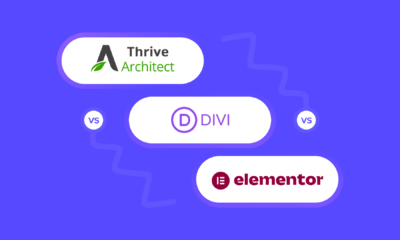SEO
How to Measure SEO ROI (Incl. 6 Challenges of Calculating It)
SEO ROI (return on investment) estimates the business value of all SEO activities in contrast to their cost. It’s one of the most common topics any SEO consultant or manager has to address when it comes to allocating marketing budgets and resources.
In its essence, calculating ROI is quite easy and straightforward. But in SEO, there are many caveats you should be aware of. Those ultimately make measuring and interpreting ROI one of the most complex and challenging problems you can face in SEO.
But we’ve got you covered and will share the ins and outs of measuring SEO ROI. In this article, we’ll go through these:
Let’s dive in.
The ROI formula for SEO is simple in essence:
SEO ROI = (value of organic conversions – cost of SEO investments)/cost of SEO investments
In other words, you need to divide the SEO profit by the associated SEO costs. Let’s expand on each variable because it can be quite tricky to get to some final numbers.
1. Calculate your SEO investments
Organic search is often viewed as a “free traffic” channel, but that’s devaluing the huge time investments that usually go into it. And those are not the only associated SEO costs.
SEO investments can usually be divided into four categories:
- In-house employees – It’s obvious to count in dedicated SEO and content creation staff, but you should also account for the required designer and developer resources.
- SEO freelancers and agencies – This is straightforward. And if you hire SEO freelancers or agencies, they can and, in many cases, should be the ones measuring SEO ROI.
- SEO tools – Count in all your subscriptions for dedicated SEO tools like Ahrefs. You can also partially include the costs of tools used by the broader marketing department if you also use them for SEO (e.g., Similarweb, BuzzSumo, HARO, PR software, etc.).
- Content distribution and link building – As we know, SEO doesn’t end with publishing content. Consider partially including costs of content promotion efforts. Also, if you buy links as one of your link building tactics, count that in. Google and many SEOs warn against buying links, but the reality of link building is often different.
Combine these costs over your desired period of time. Now, choosing the time period is one of the big challenges. We’ll expand on that later, but you can start with monthly comparisons for the sake of simplicity.
2. Calculate the value of your organic traffic conversions
You need proper conversion tracking in Google Analytics (or its alternatives) to get this number. Segment the traffic to “organic” and check the value of conversions that you want to account for in the ROI calculations:

The type of conversions and how you assign conversion values will differ from business to business.
It’s pretty straightforward for e-commerce businesses, as they send the value of sales conversions to GA.
But, for example, it may be more complex for lead generation businesses. For them, it can be helpful to assign dollar values to new marketing or sales-qualified leads.
3. Account for the value of assisted conversions
Historically, we often had to get used to working with the default “last non-direct click” attribution model in Universal Analytics.
It’s a flawed model in most cases because it assigns 100% of the conversion credit to a single marketing channel closest to the conversion event.
Here’s a good sports analogy for understanding this: It’s similar to you only praising players who score a goal. Goalkeepers and those responsible for defense won’t be too happy.
Your website likely drives organic traffic at all stages of the customer journey. Even one piece of content can target multiple steps in the marketing funnel:


For example, people may land on 10 of your articles from Google and then convert after clicking a search or retargeting ad. In that case, you’ll want to see that initial organic search contribution.
The shift to Google Analytics 4 (GA4) partially solves this problem via utilizing a data-driven attribution (DDA) model by default (more on that later).
The conversions and the values you see in all GA4 reports already account for the partial contributions of organic traffic to the overall website conversions. If you already use GA4, you don’t technically need to dive into the assisted conversions report.
Nevertheless, it’s always a good idea to check and analyze the conversion paths of your visitors and how each channel contributes to conversions.
For Universal Analytics, I already covered the process of analyzing assisted organic conversions.
In GA4, go to Advertising > Attribution > Conversion paths, select the conversion event you want to analyze, and check the impact of organic search throughout customer journeys:


You can also filter the organic traffic only to get the most relevant data, as seen in the table below:


The screenshots and data come from the official GA4 demo account, so the conversion paths are simplistic and won’t be like that in most cases. Also, feel free to play around with other attribution models to get some interesting insights there.
I can imagine this simplified process of calculating SEO ROI only raises more questions, so it’s time to dive deeper into all the nuances and caveats.
You should be aware of these challenges to calculate SEO ROI and all the other related metrics as best as you can. I’ll provide a few recommendations to apply in practice along the way.
1. Marketing attribution is inherently flawed
Marketing attribution is one of those topics that provoke many discussions. We have experts on completely opposite sides of the fence.
Some say it’s almost never worth the resources to try and solve it properly and that you should trust your gut instead. Others are convinced that proper attribution can be almost always reasonably achieved.
One thing is for sure. Attributing conversions to marketing channels is inherently flawed regardless of the attribution model used. Heuristic models like the last non-direct click will just be much more flawed than the new DDA.
Customer journeys and touchpoints are often much more complex than analytics software makes them look.
Here’s a great example of a specific buyer’s journey of a SparkToro customer. (SparkToro is the SaaS company of Rand Fishkin, who is one of those experts on the “better trust your gut” side of things.)
Let’s take a look:
As mentioned earlier, organic search traffic is a marketing channel that can span the whole customer journey from awareness to retention. Attribution is especially tricky here, so let’s discuss the implications further.
DDA is a solid solution for this that will likely shift many people closer to the “proper attribution is possible” camp. But it still doesn’t solve many other problems. It’s a black box that gets more accurate with increasing traffic and conversions.
Unless you have “higher” hundreds (or ideally thousands of conversions) a month, I’d still take those numbers with a huge grain of salt. And ultimately, no matter the attribution model, you still don’t see data from sessions where the tracking code wasn’t fired (e.g., ad blockers and quick bounces).
2. The connection between SEO and brand-building
Let’s say you browse through some YouTube videos and see someone talking about an interesting product. You Google that brand or product, head to the website, and make a purchase. Organic traffic gets 100% attribution for the conversion.
You can come up with many other scenarios where the only organic search interaction is through branded queries. SEO gets the credit when it shouldn’t.
On the other hand, you can have strong SEO with high search visibility on the SERPs throughout the whole funnel. It’s perfectly capable of converting many prospects from start to finish by itself.
But social media ads, display ads, and search ads get in the way and make a bigger contribution to the conversion just because they’re more prominent.
DDA in GA4 partly solves this problem, but it still can’t take into account the branding aspect of SEO. The brand awareness and salience you build by being seen in top-of-the-funnel content either through your own content production or by outreach aren’t things we can measure well.
Not being able to segment branded vs. non-branded organic traffic with conversion data makes all of this difficult to assess.
3. We can’t measure the retention impact of SEO
Ahrefs is a great example of this. We produce product-led content that’s constantly educating our (potential) customers about all the ways they can use our tools to solve their SEO and marketing problems.
As we neither use GA nor store cookies, I can’t back this up with data. But I’d estimate that 20-30% of organic traffic visits to our blog come from people who are already Ahrefs customers.
The retention impact of SEO, in this case, can be divided into two categories:
- As people learn to squeeze more out of our toolset, they start using the tool more and more, which leads to lowering churn rates.
- Content about tools and features included in higher-priced plans makes some people upgrade their monthly subscriptions.
In other words, SEO has the power to increase the customer lifetime value, as many pieces of content also overlap with the retention and nurturing stages of the marketing funnel.
But again, it is difficult or even impossible to take this impact into account when calculating the SEO ROI.
4. Huge time discrepancies between “investment” and “return” periods
The variables in calculating ROI are the investments and returns over certain time periods. But when we look at that on the whole website and business level, it’s impossible to tie specific investments to specific returns in SEO.
This is where the simplified principle of comparing the same monthly periods of “investments” and “returns” fails.
SEO can take a lot of time to provide returns on the investment. Yes, you can certainly have quick wins. But nothing is guaranteed.
A good alternative to choosing arbitrary time periods is to be more granular and start calculating ROI on the category, page, or keyword level. You can measure well the “return” of ranking with particular pages and can also know most of the “investments” that went into it.
We’d still omit technical SEO and other related costs and efforts that are usually applied to a broader scope of the website at once. But these partial costs are unlikely to shift a specific page from positive to negative ROI, so feel free to leave them out for simplicity’s sake—as long as you’re aware of them.
5. SEO testing has limited capabilities
One way to better understand the contribution of a marketing channel to overarching marketing objectives is to stop running campaigns on it for a while and see what happens.
For example, we ran such an experiment with PPC channels:
We’ll be reallocating our paid traffic budget (~$200k💰) for December away from the Google/Facebook—and into sponsoring the industry’s best creators and thought leaders.
— Ahrefs (@ahrefs) November 24, 2021
What you’d be looking for here is marketing incrementality—the lift the channel brings on top of a specific outcome that happens anyway.
Let’s say the outcome we want to monitor is conversions, so we’d be looking at how many conversions we’d still get if we halted specific marketing activities.
The problem with SEO is that you can’t just turn it off. Or well, you can. But no sane marketer will ever deploy noindex robots meta tag on the whole website.
Organic search is simply one of the most important channels for many businesses, and sabotaging your own SEO can have long-term detrimental effects.
This doesn’t mean that you can’t run SEO experiments and tests. You absolutely can. There’s been quite a lot of development and coverage about SEO testing in recent years.
But for the purpose of measuring incrementality and ROI, it is close to impossible for the vast majority of websites to come up with a good hypothesis and valid testing scenarios.
6. Forecasting future ROI
Last but not least, as SEOs, we’re often asked about the expected outcomes and ROI of certain SEO activities. This can get even more complicated, as SEO forecasting is a discipline on its own and can clash with all the aforementioned challenges as well.
Don’t try to beat around the bush. Instead, face the uncertainty head-on. Setting up SEO objectives and making sure we’re on the right track to achieving them is a crucial part of our job. Having good communication skills is another.
A good way to approach this is to consider the following factors when coming up with specific numbers:
- Past SEO performance of the page(s) or a website and its competitors
- Compounded traffic potential of the content in question
- Estimation of an average conversion rate (can be applied just to the bottom-of-the-funnel content for simplicity’s sake)
For SEO performance, a good start is to look up your website in Ahrefs’ Site Explorer, head over to the Performance chart in the Overview report, and add all your relevant competitors:


You can also check the traffic value (estimated monthly cost of traffic from all keywords a site is ranking for if paid via PPC):


And the number of organic pages:


This should give you an idea about the relationship between the content output and organic traffic in your niche. It still leaves out link building activities and technical SEO, but that will only complicate things here even more.
As for the traffic potential, paste all the keywords you plan to target with the new proposed content into Ahrefs’ Keywords Explorer and take a look at the Traffic Potential (TP) column:


TP in Ahrefs shows how much organic traffic the #1 ranking page for your target keyword receives from all the keywords that it ranks for in your target country. You can either analyze this on a keyword-to-keyword basis or export the list to sum up the column values.
And lastly, we have the conversion. You should already have this data available for similar content in the tracking software, and you can also look up and/or survey other websites in your niche.
By the end of this, you can extrapolate and estimate the outcome of all the proposed SEO activities. Or you can go more “granular,” as that information will always be more accurate and easier to communicate.
Of course, stay away from any guarantees. But saying something along the lines of “I expect that [SEO activity] can increase traffic by X, which could bring Y conversions” can work when you set up the right expectations.
To be honest, I’m in the camp advocating that it’s not even necessary to calculate the ROI of your SEO and related content marketing efforts. This is especially true if you can prioritize content creation and other SEO tasks well.
Our CMO, Tim Soulo, wrote a great Twitter thread about the ROI of content marketing that’s highly relevant to this topic and also shows how we think about that in Ahrefs:
Let’s talk about the “ROI of Content Marketing.“
Far too often us marketers get challenged with this question by our boss (or our client):
– How do I know that my investment in content will guarantee a positive return? …& how can I *MEASURE* it? [Read more..]— Tim Soulo 🇺🇦 (@timsoulo) March 23, 2021
So what’s the alternative? Choosing and tracking the most suitable SEO KPI that’s not based on conversions.
The best candidate for this KPI, in most cases, is search visibility. It’s the SEO version of one of the most important marketing KPIs, share of voice (SOV), which measures how visible your brand is in the market.
That’s important because there’s a strong relationship between SOV and market share. Generally speaking, the higher your SOV, the bigger your share of the pie.


For the most accurate tracking of search visibility, paste the keywords that matter to you into Ahrefs’ Rank Tracker. Note that these should be the main keywords that encompass what your target audience is searching for (don’t bother with long-tails).


From there, head to the Competitors Overview tab and check the Visibility column:


That’s it. As long as you see a long-term growth trend in the search visibility for your website, you should be confident that your SEO efforts are paying off.
I know this isn’t a possible alternative for many teams that are required to show “money metrics,” but it’s definitely worth tracking as one of your SEO KPIs.
Final thoughts
I could have taken the easy path here and just touched the surface without diving into all the challenges and caveats of calculating SEO ROI. But this is what stakeholders care about the most, so we should all be knowledgeable and confident in communicating these matters.
Many topics covered here can be in-depth standalone articles. If you’re interested in learning more about everything related to marketing analytics and attribution, I highly recommend you check out the blog of Avinash Kaushik.
Got questions or interesting insights regarding SEO ROI? Ping me on Twitter.
SEO
Google On Hyphens In Domain Names

Google’s John Mueller answered a question on Reddit about why people don’t use hyphens with domains and if there was something to be concerned about that they were missing.
Domain Names With Hyphens For SEO
I’ve been working online for 25 years and I remember when using hyphens in domains was something that affiliates did for SEO when Google was still influenced by keywords in the domain, URL, and basically keywords anywhere on the webpage. It wasn’t something that everyone did, it was mainly something that was popular with some affiliate marketers.
Another reason for choosing domain names with keywords in them was that site visitors tended to convert at a higher rate because the keywords essentially prequalified the site visitor. I know from experience how useful two-keyword domains (and one word domain names) are for conversions, as long as they didn’t have hyphens in them.
A consideration that caused hyphenated domain names to fall out of favor is that they have an untrustworthy appearance and that can work against conversion rates because trustworthiness is an important factor for conversions.
Lastly, hyphenated domain names look tacky. Why go with tacky when a brandable domain is easier for building trust and conversions?
Domain Name Question Asked On Reddit
This is the question asked on Reddit:
“Why don’t people use a lot of domains with hyphens? Is there something concerning about it? I understand when you tell it out loud people make miss hyphen in search.”
And this is Mueller’s response:
“It used to be that domain names with a lot of hyphens were considered (by users? or by SEOs assuming users would? it’s been a while) to be less serious – since they could imply that you weren’t able to get the domain name with fewer hyphens. Nowadays there are a lot of top-level-domains so it’s less of a thing.
My main recommendation is to pick something for the long run (assuming that’s what you’re aiming for), and not to be overly keyword focused (because life is too short to box yourself into a corner – make good things, course-correct over time, don’t let a domain-name limit what you do online). The web is full of awkward, keyword-focused short-lived low-effort takes made for SEO — make something truly awesome that people will ask for by name. If that takes a hyphen in the name – go for it.”
Pick A Domain Name That Can Grow
Mueller is right about picking a domain name that won’t lock your site into one topic. When a site grows in popularity the natural growth path is to expand the range of topics the site coves. But that’s hard to do when the domain is locked into one rigid keyword phrase. That’s one of the downsides of picking a “Best + keyword + reviews” domain, too. Those domains can’t grow bigger and look tacky, too.
That’s why I’ve always recommended brandable domains that are memorable and encourage trust in some way.
Read the post on Reddit:
Read Mueller’s response here.
Featured Image by Shutterstock/Benny Marty
SEO
Reddit Post Ranks On Google In 5 Minutes

Google’s Danny Sullivan disputed the assertions made in a Reddit discussion that Google is showing a preference for Reddit in the search results. But a Redditor’s example proves that it’s possible for a Reddit post to rank in the top ten of the search results within minutes and to actually improve rankings to position #2 a week later.
Discussion About Google Showing Preference To Reddit
A Redditor (gronetwork) complained that Google is sending so many visitors to Reddit that the server is struggling with the load and shared an example that proved that it can only take minutes for a Reddit post to rank in the top ten.
That post was part of a 79 post Reddit thread where many in the r/SEO subreddit were complaining about Google allegedly giving too much preference to Reddit over legit sites.
The person who did the test (gronetwork) wrote:
“…The website is already cracking (server down, double posts, comments not showing) because there are too many visitors.
…It only takes few minutes (you can test it) for a post on Reddit to appear in the top ten results of Google with keywords related to the post’s title… (while I have to wait months for an article on my site to be referenced). Do the math, the whole world is going to spam here. The loop is completed.”
Reddit Post Ranked Within Minutes
Another Redditor asked if they had tested if it takes “a few minutes” to rank in the top ten and gronetwork answered that they had tested it with a post titled, Google SGE Review.
gronetwork posted:
“Yes, I have created for example a post named “Google SGE Review” previously. After less than 5 minutes it was ranked 8th for Google SGE Review (no quotes). Just after Washingtonpost.com, 6 authoritative SEO websites and Google.com’s overview page for SGE (Search Generative Experience). It is ranked third for SGE Review.”
It’s true, not only does that specific post (Google SGE Review) rank in the top 10, the post started out in position 8 and it actually improved ranking, currently listed beneath the number one result for the search query “SGE Review”.
Screenshot Of Reddit Post That Ranked Within Minutes
Anecdotes Versus Anecdotes
Okay, the above is just one anecdote. But it’s a heck of an anecdote because it proves that it’s possible for a Reddit post to rank within minutes and get stuck in the top of the search results over other possibly more authoritative websites.
hankschrader79 shared that Reddit posts outrank Toyota Tacoma forums for a phrase related to mods for that truck.
Google’s Danny Sullivan responded to that post and the entire discussion to dispute that Reddit is not always prioritized over other forums.
Danny wrote:
“Reddit is not always prioritized over other forums. [super vhs to mac adapter] I did this week, it goes Apple Support Community, MacRumors Forum and further down, there’s Reddit. I also did [kumo cloud not working setup 5ghz] recently (it’s a nightmare) and it was the Netgear community, the SmartThings Community, GreenBuildingAdvisor before Reddit. Related to that was [disable 5g airport] which has Apple Support Community above Reddit. [how to open an 8 track tape] — really, it was the YouTube videos that helped me most, but it’s the Tapeheads community that comes before Reddit.
In your example for [toyota tacoma], I don’t even get Reddit in the top results. I get Toyota, Car & Driver, Wikipedia, Toyota again, three YouTube videos from different creators (not Toyota), Edmunds, a Top Stories unit. No Reddit, which doesn’t really support the notion of always wanting to drive traffic just to Reddit.
If I guess at the more specific query you might have done, maybe [overland mods for toyota tacoma], I get a YouTube video first, then Reddit, then Tacoma World at third — not near the bottom. So yes, Reddit is higher for that query — but it’s not first. It’s also not always first. And sometimes, it’s not even showing at all.”
hankschrader79 conceded that they were generalizing when they wrote that Google always prioritized Reddit. But they also insisted that that didn’t diminish what they said is a fact that Google’s “prioritization” forum content has benefitted Reddit more than actual forums.
Why Is The Reddit Post Ranked So High?
It’s possible that Google “tested” that Reddit post in position 8 within minutes and that user interaction signals indicated to Google’s algorithms that users prefer to see that Reddit post. If that’s the case then it’s not a matter of Google showing preference to Reddit post but rather it’s users that are showing the preference and the algorithm is responding to those preferences.
Nevertheless, an argument can be made that user preferences for Reddit can be a manifestation of Familiarity Bias. Familiarity Bias is when people show a preference for things that are familiar to them. If a person is familiar with a brand because of all the advertising they were exposed to then they may show a bias for the brand products over unfamiliar brands.
Users who are familiar with Reddit may choose Reddit because they don’t know the other sites in the search results or because they have a bias that Google ranks spammy and optimized websites and feel safer reading Reddit.
Google may be picking up on those user interaction signals that indicate a preference and satisfaction with the Reddit results but those results may simply be biases and not an indication that Reddit is trustworthy and authoritative.
Is Reddit Benefiting From A Self-Reinforcing Feedback Loop?
It may very well be that Google’s decision to prioritize user generated content may have started a self-reinforcing pattern that draws users in to Reddit through the search results and because the answers seem plausible those users start to prefer Reddit results. When they’re exposed to more Reddit posts their familiarity bias kicks in and they start to show a preference for Reddit. So what could be happening is that the users and Google’s algorithm are creating a self-reinforcing feedback loop.
Is it possible that Google’s decision to show more user generated content has kicked off a cycle where more users are exposed to Reddit which then feeds back into Google’s algorithm which in turn increases Reddit visibility, regardless of lack of expertise and authoritativeness?
Featured Image by Shutterstock/Kues
SEO
WordPress Releases A Performance Plugin For “Near-Instant Load Times”

WordPress released an official plugin that adds support for a cutting edge technology called speculative loading that can help boost site performance and improve the user experience for site visitors.
Speculative Loading
Rendering means constructing the entire webpage so that it instantly displays (rendering). When your browser downloads the HTML, images, and other resources and puts it together into a webpage, that’s rendering. Prerendering is putting that webpage together (rendering it) in the background.
What this plugin does is to enable the browser to prerender the entire webpage that a user might navigate to next. The plugin does that by anticipating which webpage the user might navigate to based on where they are hovering.
Chrome lists a preference for only prerendering when there is an at least 80% probability of a user navigating to another webpage. The official Chrome support page for prerendering explains:
“Pages should only be prerendered when there is a high probability the page will be loaded by the user. This is why the Chrome address bar prerendering options only happen when there is such a high probability (greater than 80% of the time).
There is also a caveat in that same developer page that prerendering may not happen based on user settings, memory usage and other scenarios (more details below about how analytics handles prerendering).
The Speculative Loading API solves a problem that previous solutions could not because in the past they were simply prefetching resources like JavaScript and CSS but not actually prerendering the entire webpage.
The official WordPress announcement explains it like this:
Introducing the Speculation Rules API
The Speculation Rules API is a new web API that solves the above problems. It allows defining rules to dynamically prefetch and/or prerender URLs of certain structure based on user interaction, in JSON syntax—or in other words, speculatively preload those URLs before the navigation. This API can be used, for example, to prerender any links on a page whenever the user hovers over them.”
The official WordPress page about this new functionality describes it:
“The Speculation Rules API is a new web API… It allows defining rules to dynamically prefetch and/or prerender URLs of certain structure based on user interaction, in JSON syntax—or in other words, speculatively preload those URLs before the navigation.
This API can be used, for example, to prerender any links on a page whenever the user hovers over them. Also, with the Speculation Rules API, “prerender” actually means to prerender the entire page, including running JavaScript. This can lead to near-instant load times once the user clicks on the link as the page would have most likely already been loaded in its entirety. However that is only one of the possible configurations.”
The new WordPress plugin adds support for the Speculation Rules API. The Mozilla developer pages, a great resource for HTML technical understanding describes it like this:
“The Speculation Rules API is designed to improve performance for future navigations. It targets document URLs rather than specific resource files, and so makes sense for multi-page applications (MPAs) rather than single-page applications (SPAs).
The Speculation Rules API provides an alternative to the widely-available <link rel=”prefetch”> feature and is designed to supersede the Chrome-only deprecated <link rel=”prerender”> feature. It provides many improvements over these technologies, along with a more expressive, configurable syntax for specifying which documents should be prefetched or prerendered.”
See also: Are Websites Getting Faster? New Data Reveals Mixed Results
Performance Lab Plugin
The new plugin was developed by the official WordPress performance team which occasionally rolls out new plugins for users to test ahead of possible inclusion into the actual WordPress core. So it’s a good opportunity to be first to try out new performance technologies.
The new WordPress plugin is by default set to prerender “WordPress frontend URLs” which are pages, posts, and archive pages. How it works can be fine-tuned under the settings:
Settings > Reading > Speculative Loading
Browser Compatibility
The Speculative API is supported by Chrome 108 however the specific rules used by the new plugin require Chrome 121 or higher. Chrome 121 was released in early 2024.
Browsers that do not support will simply ignore the plugin and will have no effect on the user experience.
Check out the new Speculative Loading WordPress plugin developed by the official core WordPress performance team.
How Analytics Handles Prerendering
A WordPress developer commented with a question asking how Analytics would handle prerendering and someone else answered that it’s up to the Analytics provider to detect a prerender and not count it as a page load or site visit.
Fortunately both Google Analytics and Google Publisher Tags (GPT) both are able to handle prerenders. The Chrome developers support page has a note about how analytics handles prerendering:
“Google Analytics handles prerender by delaying until activation by default as of September 2023, and Google Publisher Tag (GPT) made a similar change to delay triggering advertisements until activation as of November 2023.”
Possible Conflict With Ad Blocker Extensions
There are a couple things to be aware of about this plugin, aside from the fact that it’s an experimental feature that requires Chrome 121 or higher.
A comment by a WordPress plugin developer that this feature may not work with browsers that are using the uBlock Origin ad blocking browser extension.
Download the plugin:
Speculative Loading Plugin by the WordPress Performance Team
Read the announcement at WordPress
Speculative Loading in WordPress
See also: WordPress, Wix & Squarespace Show Best CWV Rate Of Improvement
-

 PPC6 days ago
PPC6 days agoCompetitor Monitoring: 7 ways to keep watch on the competition
-

 SEARCHENGINES6 days ago
SEARCHENGINES6 days agoMore Google March 2024 Core Update Ranking Volatility
-

 PPC6 days ago
PPC6 days ago31 Ready-to-Go Mother’s Day Messages for Social Media, Email, & More
-

 PPC6 days ago
PPC6 days agoA History of Google AdWords and Google Ads: Revolutionizing Digital Advertising & Marketing Since 2000
-

 WORDPRESS5 days ago
WORDPRESS5 days agoTurkish startup ikas attracts $20M for its e-commerce platform designed for small businesses
-

 WORDPRESS7 days ago
WORDPRESS7 days agoThrive Architect vs Divi vs Elementor
-

 MARKETING5 days ago
MARKETING5 days agoRoundel Media Studio: What to Expect From Target’s New Self-Service Platform
-

 SEARCHENGINES5 days ago
SEARCHENGINES5 days agoGoogle Search Results Can Be Harmful & Dangerous In Some Cases















You must be logged in to post a comment Login